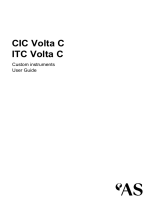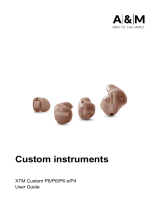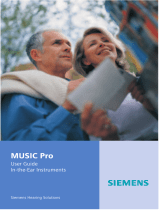Page is loading ...

ReSound Essence ITE, ITC & CIC
ES50, ES50-D, ES50-P, ES50-DP,
ES30, ES30-D, ES30-P, ES30-DP
ES10, ES10-P

2
3
RESOUND Essence
IN-THE-EAR HEARING INSTRUMENTS
PERSONAL HEARING SYSTEM
Congratulations on the purchase of your new fully-digital
GN ReSound hearing instrument!
This booklet describes the features available for the custom t
hearing instrument models in the ReSound Essence product
line. The available options depend on the hearing instrument
model; your hearing care professional will highlight the fea-
tures of your particular hearing instrument.
GN ReSound’s advanced technology and customized program-
mes, selected by your hearing care professional, will offer you
the best possible hearing solution to maximize listening situa-
tions in your family life, your professional life and your social
life.
Your hearing instrument has been adjusted for your individual
hearing loss. Please familiarize yourself with the information
in this booklet. Proper understanding and use of your new
GN ReSound hearing instrument will allow you to derive maxi-
mum hearing benet.
This instruction manual covers the following ReSound Essence
custom products: ES50, ES50-D, ES50-P, ES50-DP, ES30, ES30-D,
ES30-P, ES30-DP, ES10 and ES10-P
ReSound Essence is a trademark of GN ReSound A/S.
This booklet & your instrument
In this booklet you will nd instructions for inserting, using and
caring for your new hearing instrument.
Contents page
Your ReSound Essence Hearing Instrument ....................4
On/Off Function ..................................................5
Low Battery Warning ............................................5
Changing the Battery ............................................6
Battery Warning Information....................................7
Inserting the Instrument.........................................8
Removing the Instrument........................................9
Recognizing Left & Right instrument..........................10
Volume Control.................................................11
Programme Selector ...........................................12
Your Programme Environments ...............................12
T-programme ................................................... 13
Directionality . . . . . . . . . . . . . . . . . . . . . . . . . . . . . . . . . . . . . . . . . . . . . . . . . . 13
Hearing through Induction loop............................... 15
Daily Maintenance ............................................. 16
Cleaning the Microphone Sound Inlet.........................16
Repairs.......................................................... 17
Troubleshooting Guide......................................18-19
General Precautions ........................................... 20
Technical Data..................................................21
Key Word Index.................................................22

4
5
Your ReSound Essence ES10 and ES10-P Hearing Instruments
Your ReSound Essence ES30, ES30-D, ES30-P and ES30-DP
Hearing Instruments
Your ReSound Essence ES50, ES50-D, ES50-P and ES50-DP
Hearing Instruments
Turning on and off
Your ReSound Essence custom aid is
equipped with an on/off switch integrated
into the battery compartment. Turn your
hearing instrument on by closing the battery
door. Turn your instrument off by opening
up the battery door. When rst turned on, your hearing instru-
ment will always start in program 1. To read more on this sub-
ject, turn to page 12
• Turning your instrument off when you are not using it will in-
crease the battery life.
• At night, turn off your instrument and open the battery door
completely. It will allow moisture in your instrument to evapo-
rate and will increase the instrument’s life span.
Wax guard
Microphone opening
Pull out cord
Battery door
Vent (optional)
Wax guard
Microphone opening
Volume wheel
(optional)
Battery door
Programme button
(optional)
Wax guard
Microphone
opening
Volume wheel
(optional)
Battery door
Programme button
(optional)
Vent (optional)
On-close
Off-open
Microphone opening
Microphone
opening

6
7
Low Battery Warning
The hearing instrument has a soft low-battery-warning signal
(beep-beep) that you will hear when the battery voltage/power
gets too low. The signal indicates you should replace the bat-
tery. We recommend that you always carry a spare battery with
you. The battery-warning signal will be repeated every 5-10 mi-
nutes until the battery runs out of power. The instrument will
then automatically turn off.
Changing the Battery
Open the battery compartment
completely, using your nger-
nail to pull back on the small
ridge located at the top of the
door. After removing the old
battery, insert the new one with
the“+” (at) side facing the “+”
on the battery door. Make sure
the battery has been placed cor-
rectly into the slot.
Instrument type Battery type
ES10/ES10-P CIC/CIC P 10A zinc-air
ES30/ES30-D/ES30-P/ES30-DP ITC/ITC-D/ITC-P/ITC-DP 312 zinc-air
ES50/ES50-D/ES50-P/ES50-DP ITE/ITE-D/ITE-P/ITE-DP 13 zinc-air
Please note that if the battery is weak, the hearing instrument
performance will be reduced. Removing the battery when you
are not wearing the instrument will help prevent corrosion of
the battery contacts and prolong battery life.
Battery Warning Information
Batteries contain dangerous substances and should be dis-
posed of carefully in the interest of your safety and for the
environment.
• Do NOT attempt to recharge batteries which are not speci-
cally designated rechargeable as they may leak or explode.
• Do NOT attempt to dispose of batteries by burning them.
• Keep batteries away from small children and pets.
• Do NOT place batteries in your mouth.
If swallowed, seek immediate medical attention.

8
9
Inserting your instrument
To insert the hearing instrument
into your ear:
1. Grip the instrument with your
thumb and forenger, either
above, below or on the sides
of the hearing instrument (as
shown). The programme button
should always be located on the
outer top portion of the instru-
ment.
2. Place the sound outlet portion
into your ear canal.
3. Insert the hearing instrument
carefully with a slight “cork-
screw” motion.
By experimenting, you may nd a method that is easier for you.
When properly inserted, the instrument should t comfortably
and snugly in your ear. It is important that the custom shell ts
correctly into your ear. If your hearing instrument irritates your
ear in any way and prevents you from wearing your hearing in-
strument, please contact your hearing care professional to have
the custom shell modied. You should never attempt to modify
the shape of the custom shell yourself.
Removing your instrument
To remove the hearing instrument:
1. Gently massage behind your
earlobe with an upward and
downward motion to dislodge
the instrument.
2. Place your thumb on the bot-
tom of the instrument and your forenger on the top. Care-
fully remove the instrument from your ear canal with a slight
“corkscrew” motion.
By experimenting, you may nd a method that is easier for you.
Consult your hearing care professional if you have difculty
removing the hearing instrument.

10
11
Recognising left and right instrument
Your hearing instrument is custom-made to t your ear. There-
fore, right and left instruments differ in shape.
Your hearing instrument is marked with either a left or right in-
dication:
• A left instrument has a blue wax guard or blue dot;
• A right instrument has a red wax guard or red dot.
This is easy to remember: Red = Right.
The colour dot must point upwards on the CIC instruments
when inserted into the ear.
Do not swap your hearing instruments. Please pay attention to
this during cleaning, storing, and inserting.
Volume Control
Certain ITE or ITC models are equip-
ped with a volume control that al-
lows you to set and control the
volume manually.This option is not
available for CIC instruments.
During the tting of the instrument,
your hearing care practitioner will
select an optimal volume setting
for you. Please note this setting level.
To increase the volume with the instrument t to your ear, turn
the volume control wheel clockwise (towards the front of your
head). To reduce the volume, turn the volume control wheel
counter-clockwise (towards the back of your head.).
Please note that your instrument has been t by your hearing
care professional and that your hearing loss requires a certain
amount of amplication. This will also effect how much you are
able to increase the volume on your instrument.
If you prefer not to use the volume wheel your hearing care
practitioner can disable it..

12
13
Programme Selector
Certain hearing instrument models are
equipped with a push button. This en-
ables you to have up to three listening
programmes, each of them suitable for
different situations. The number of pro-
grammes available will vary depending
on the model.
If you have an ITE or ITC hearing instrument, your hearing care
professional can programme multiple programmes into your in-
strument. You can select programmes simply by depressing the
programme selector once. You will then hear one, two or three
” beeps”, indicating which programme you have selected. Your
hearing instrument will switch programmes as follows:
Examples:
If you have at least 2 programmes: If you are in the default pro-
gramme, programme 1, press the programme button once to
get to programme 2. You will hear 2 beeps when you are in pro-
gramme 2.
3 programmes: If you are in programme 1, press the programme
button twice to get to programme 3. You will hear 3 beeps when
you are in programme 3.
To get back to programme 1, press the programme button, until
you hear just 1 beep.
You can also get back to programme 1 by turning your instru-
ment off and then on again.
Your Programme Environments
Let your Hearing Care Professional ll out the following table:
No. Programme
Description of when to use
programme Type
T-programme (Telecoil programme)
Your hearing instrument might have a built in function, the te-
lecoil, which can enable you to hear better on the telephone
and in churches or halls that have an induction loop system in-
stalled in them. In order to activate this function, the telecoil
programme has to be selected. In this programme you typically
will hear no sounds from the microphone, therefore most en-
vironmental sounds will be lost. If you wish, your hearing care
practitioner can change the setting in such a way that you hear
the microphone and the telecoil simultaneously.
Directionality
The ReSound Essence models ES30-D, ES30-DP, ES50-D and
ES50-DP are equipped with two microphones and thus offer
directionality. The purpose of directionality is to enhance
speech understanding in noisy situations. Directionality makes
it easier to hear speech in front of you, while sounds coming
from the back are suppressed. Please ask your hearing care
professional how to activate directionality.

14
15
Using the telephone with induction loop.
• Switch your instrument to the
tele coil programme.
• Hold your telephone handset be-
hind your ear, close to the hearing
instrument (2- 3 cm.) and slightly
tilt the receiver outwards.
• Listen to the dial tone and move
the handset a little to nd the position that gives the best re-
ception.
• If necessary, turn the volume up or down.
• When nished using the phone, switch your instrument back
to the microphone programme.
If the phone you are using has a poor telecoil signal, or your
instrument does not have a telecoil, use program 1 instead.
Do not hold the handset too tightly against your ear since this
extra period might cause ’whistling’.
Hearing through an induction loop
Many public places, churches, theatres and cinemas, have in-
duction loop systems. In these particular rooms, the induction
loops transmit, wirelessly, the sound of the presenter or show.
At home, radio or television can be connected to an induction
loop system. Sound quality through an induction loop is often
better because noise from the environment is not amplied.
• Switch your instrument to the telecoil programme.
• Choose a good location. Reception is not clear in all loca tions;
it depends on the position of the induction loop. Watch for
signs or try moving your seat.
• If necessary, adjust the volume up or down.
• After the service or show, switch your instrument back to
standard programme. You will now hear through the micro-
phone again.
• If the sound in the telecoil program is too soft, ask your he-
aring care practitioner to make an adjustment.
• Your hearing care practitioner will gladly provide you with
advice regarding an induction loop system at home. Ask for
it.

16
17
Daily Maintenance
Keep your hearing instrument clean
and dry. Wipe the case with a soft
cloth/brush or tissue after use to
remove oil or moisture. If the instru-
ment has been exposed to high hu-
midity or perspiration, enclose it in a sealed container together
with a drying agent (desiccant) overnight. Consult with your
hearing care professional regarding which drying agent to use.
To avoid the need for unwarranted repairs:
• Never immerse the instrument in
water or other liquids since this
may cause permanent damage
to the circuitry.
• Protect your hearing instrument
from rough handling, and avoid
dropping it on hard surfaces or
oors.
• Do not leave the instrument in or near direct heat or sunlight
since excessive heat can damage the instrument or deform
the casing.
Cleaning the Microphone Sound Inlet
For proper function of the microphone, it is important to clean
the sound inlet to remove dust, ear wax or other debris. The soft
brush, provided with your hearing instrument, can be used for
this purpose. Consult your hearing care professional regarding
proper use of the tool.
Changing the Sound Outlet Filter/Cleaning the Sound Outlet
Your ReSound Essence hearing instrument may be equipped
with a sound outlet lter (consult your hearing care profes-
sional). This lter is located at the end of the sound outlet and
prevents debris from getting into the hearing instrument. If the
hearing instrument seems to have lost power and changing the
battery does not help, the lter may be blocked, and need to
be changed. Your hearing care professional can instruct you
on how to change the lter. If your hearing instrument does
not have a lter, ear wax and/or other debris may collect in the
sound channel. The cleaning loop, provided with your hearing
instrument, can easily be used to remove this material. Your he-
aring care professional can instruct you on how to properly use
this tool. When using this tool, be careful not to damage or pull
the tubing placed at the opening of the sound outlet. If this is
pulled out, the hearing instrument may need to be returned for
repair.
Repairs
If your GN ReSound hearing instrument malfunctions, it must
be repaired by a qualied technician. Do not attempt to open
the case of the hearing instrument since this would invalidate
the warranty. If your GN ReSound hearing instrument requires
service, please contact your hearing care professional for assi-
stance.

18
19
TROUBLESHOOTING GUIDE
SYMPTOM CAUSE
No sound • Not turned on
• Dead battery
• Battery improperly inserted
• Blocked sound outlet lter
Not loud • Loose shell
enough • Change in hearing
• Excessive ear wax
• Blocked sound outlet lter
• Volume set too low
Whistles • Loose shell
• DFS needs re-initialization
Sound not clear • Weak battery
or distorted • Poorly tting shell
• Hearing instrument damaged
• Hearing instrument settings not optimal
If you experience additional problems not addressed in this
guide, please contact your hearing care professional.
POSSIBLE REMEDY
• Turn on
• Replace battery
• Insert battery properly
• Change lter or consult your hearing care professional
• Reinsert carefully
• Consult your hearing care professional
• Consult your physician
• Change lter or consult your hearing care professional
• Consult your hearing care professional
• Remove and reinsert
• Consult your hearing care professional
• Replace battery
• Consult your hearing care professional
• Consult your hearing care professional
• Consult your hearing care professional

20
21
Technical Data
Maximum Output (2cc Coupler / IEC 60118-7)
ES10 110 dB SPL (Typical)
ES10-P 116 dB SPL (Typical)
ES30/ES30-D 112 dB SPL (Typical)
ES30-P/ES30-DP 120 dB SPL (Typical)
ES50/ES50-D 120 dB SPL (Typical)
ES50-P/ES50-DP 125 dB SPL (Typical)
General Precautions
• Consult a physician if you nd a foreign object in your ear
canal, if you experience skin irritation or if excessive earwax
accumulates with the use of the hearing instrument.
• Different types of radiation, e.g. from NMR, MRI or CT scan-
ners, may damage the hearing instrument. Therefore, do not
wear the hearing instrument during these or other correspon-
ding scanning procedures. Other types of radiation (burglar
alarms, room surveillance systems, radio equipment, mobile
telephones, etc) contain less energy and will not damage the
hearing instrument. They could however momentarily affect
the sound quality or create strange sounds from the hearing
instruments.
• Warning: Do not wear the hearing instrument in mines or
other explosive areas, unless those areas are certied for
hearing instrument use.

22
23
Key Word Index
Battery change ..........................................5, 6, 18, 19
Battery compartment..........................................5, 6
Cleaning the instrument .....................................10, 16
Environmental programmes....................................12
Low battery warning...........................................5, 7
Maintenance .................................................... 15
On/off switch......................................................5
Precautions......................................................20
Programme Selector ..........................................8, 12
Technical data ...................................................20
Telecoil use ...................................................13, 14
Telephone use ................................................13, 17
Troubleshooting guide .......................................18, 19
Volume control ...........................................11, 14, 18
Any issues relating to the EU Medical Device Directive
93/42/EEC should be directed to GN ReSound A/S.
Faceplate/Electronics by: GN ReSound A/S

GN ReSound A/S
Lautrupbjerg 7
DK-2750 Ballerup, Denmark
Tel.: +45 45 75 11 11
Fax: +45 45 75 11 19
www.resound.com
GN ReSound Ltd.
1 Landscape Close
Weston Business Park
Weston-on-the-Green
Oxon OX25 3SX
Tel.: 0 1869 343 500
Fax: 0 1869 343 466
www.gnresound.co.uk
GN ReSound Pty. Ltd.
Unit R1 Regent Park Estate
391 Park Road
Regent Park NSW 2143
Tel.: (free) 1800 658 955
Fax: 02 9743 7472
www.gnresound.com.au
GN ReSound (NZ) Ltd.
12 Parkway Drive
Mairangi Bay
Auckland
Tel.: (free) 0800 900 126
Fax: (free) 0800 007 695
www.gnresound.co.nz
16715400-GB-08.10 Rev.B
/




